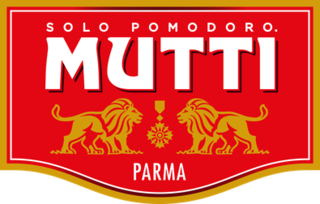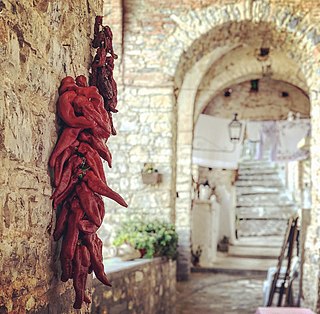
Nuoro is a city and comune (municipality) in central-eastern Sardinia, Italy, situated on the slopes of Mount Ortobene. It is the capital of the province of Nuoro. With a population of 36,347 (2011), it is the sixth-largest city in Sardinia. Its frazione (borough) of Lollove is one of I Borghi più belli d'Italia.

Pasta is a type of food typically made from an unleavened dough of wheat flour mixed with water or eggs, and formed into sheets or other shapes, then cooked by boiling or baking. Unlike noodles, pasta was traditionally only made with durum, although the definition has been expanded to include alternatives for a gluten-free diet such as rice flour, or legumes such as beans or lentils. While noodles are believed to have originated in Asia, pasta is believed to have originated in Italy and is a staple food of Italian cuisine, with evidence of Etruscans making pasta as early as 400 BCE in Italy.

Tomato sauce can refer to many different sauces made primarily from tomatoes, usually to be served as part of a dish, rather than as a condiment. Tomato sauces are common for meat and vegetables, but they are perhaps best known as bases for sauces for Mexican salsas and Italian pasta dishes. Tomatoes have a rich flavor, high water content, soft flesh which breaks down easily, and the right composition to thicken into a sauce when stewed without the need for thickeners such as roux or masa. All of these qualities make them ideal for simple and appealing sauces.

Sansepolcro, formerly Borgo Santo Sepolcro, is a town and comune founded in the 11th century, located in the Italian Province of Arezzo in the eastern part of the region of Tuscany.

Sugo all'amatriciana, or alla matriciana, also known as salsa all'amatriciana, is a traditional Italian pasta sauce based on guanciale, pecorino romano cheese, tomato, and, in some variations, onion. Originating from the town of Amatrice, the amatriciana is one of the best known pasta sauces in present-day Roman and Italian cuisine. The Italian government has named it a traditional agro-alimentary product of Lazio and amatriciana tradizionale is registered as a traditional speciality guaranteed in the EU and the UK.

Collecchio is a town in the province of Parma, Emilia-Romagna, northern Italy. It is located 12.9 kilometres (8.0 mi) by road southwest of the centre of Parma. A major food-producing area, it is home to multinational Italian dairy and food corporation Parmalat and the Parma F.C. training complex, Centro Sportivo di Collecchio, and is connected by railway. Under the Romans the town was called Sustrina, Later, in Christian times it was called, Colliculum, because of its location on a small hill. In 2015, Collecchio became recognized as the first community to mandate that all fireworks set off in the town be silent.

Barilla G. e R. Fratelli S.p.A. is an Italian multinational food company. It is the world's largest pasta producer.

Fratelli Saclà S.p.A. is a multinational Italian food company founded by Secondo Ercole and his wife Piera Campanella in Asti, Piedmont, in north-west Italy in 1923.

The Museo di Roma is a museum in Rome, Italy, part of the network of Roman civic museums. The museum was founded in the Fascist era with the aim of documenting the local history and traditions of the "old Rome" that was rapidly disappearing, but following many donations and acquisitions of works of art is now principally an art museum. The collections initially included 120 water-colours by the nineteenth-century painter Ettore Roesler Franz of Roma sparita, "vanished Rome", later moved to the Museo di Roma in Trastevere.
The Museum of Pasta is an Italian ethnographic museum dedicated to pasta. It is located in Corte di Giarola, between Collecchio and Ozzano Taro, in the Province of Parma, a region historically dedicated to the production and processing of pasta. The museum shares space with the Museum of Tomato.
Corte di Giarola is an Italian medieval rural court with an inner church, located in the village of Pontescodogna, part of commune of Collecchio, in Province of Parma. Corte di Giarola is presently a multi-purpose facility. It includes the headquarters of the Ente di Gestione per i Parchi and Biodiversità Emilia Occidentale. It also hosts the Museum of Tomato, the. being part of Museum of Food, the Museo Sotto il segno dell'Acqua which is an exhibition trail dedicated to the Taro River Regional Park, in addition to small 99-seat theatre called Teatro alla Corte, plus an auditorium hall, two conference rooms and a restaurant.

Pomodorino di Manduria is an ecotype of tomato typical of Manduria, a city in the province of Taranto. In the local dialect, it is also called pummitoru paisanu.

The capuliato or capuliatu is a traditional condiment of Sicilian cuisine based on dried tomatoes, linked, in particular to the territory of the Vittoria Plain, in free municipal consortium of Ragusa. The original name is capuliato, which means 'minced'.

Mutti - Industria Conserve Alimentari is an Italian company that specialises in preserved food, particularly in the tomato sector, founded in 1899 in Piazza di Basilicanova, a district in Montechiarugolo, in the province of Parma.

Storci S.p.A. is an Italian pasta processing equipment manufacturer. The company is based in Collecchio, Parma, Italy.

The cuisine of Basilicata, or Lucanian cuisine, is the cuisine of the Basilicata region of Italy. It is mainly based on the use of pork and sheep meat, legumes, cereals and vegetables, with the addition of aromas such as hot peppers, powdered raw peppers and horseradish. The local gastronomy is, for historical-cultural reasons, typically peasant, based on simple recipes and on the culture of reuse, in particular of meat and bread.

Cappelletti are ring-shaped Italian stuffed pasta so called for the characteristic shape that resembles a hat. Compared to tortellini, they have a different shape, larger size, thicker dough and different filling.
















